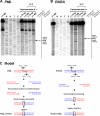Molecular analysis of t(15;17) genomic breakpoints in secondary acute promyelocytic leukemia arising after treatment of multiple sclerosis
- PMID: 18650449
- PMCID: PMC2954750
- DOI: 10.1182/blood-2007-10-115600
Molecular analysis of t(15;17) genomic breakpoints in secondary acute promyelocytic leukemia arising after treatment of multiple sclerosis
Abstract
Therapy-related acute promyelocytic leukemia (t-APL) with t(15;17) translocation is a well-recognized complication of cancer treatment with agents targeting topoisomerase II. However, cases are emerging after mitoxantrone therapy for multiple sclerosis (MS). Analysis of 12 cases of mitoxantrone-related t-APL in MS patients revealed an altered distribution of chromosome 15 breakpoints versus de novo APL, biased toward disruption within PML intron 6 (11 of 12, 92% vs 622 of 1022, 61%: P = .035). Despite this intron spanning approximately 1 kb, breakpoints in 5 mitoxantrone-treated patients fell within an 8-bp region (1482-9) corresponding to the "hotspot" previously reported in t-APL, complicating mitoxantrone-containing breast cancer therapy. Another shared breakpoint was identified within the approximately 17-kb RARA intron 2 involving 2 t-APL cases arising after mitoxantrone treatment for MS and breast cancer, respectively. Analysis of PML and RARA genomic breakpoints in functional assays in 4 cases, including the shared RARA intron 2 breakpoint at 14 446-49, confirmed each to be preferential sites of topoisomerase IIalpha-mediated DNA cleavage in the presence of mitoxantrone. This study further supports the presence of preferential sites of DNA damage induced by mitoxantrone in PML and RARA genes that may underlie the propensity to develop this subtype of leukemia after exposure to this agent.
Figures



Similar articles
-
Evidence for direct involvement of epirubicin in the formation of chromosomal translocations in t(15;17) therapy-related acute promyelocytic leukemia.Blood. 2010 Jan 14;115(2):326-30. doi: 10.1182/blood-2009-07-235051. Epub 2009 Nov 2. Blood. 2010. PMID: 19884644 Free PMC article.
-
Analysis of t(15;17) chromosomal breakpoint sequences in therapy-related versus de novo acute promyelocytic leukemia: association of DNA breaks with specific DNA motifs at PML and RARA loci.Genes Chromosomes Cancer. 2010 Aug;49(8):726-32. doi: 10.1002/gcc.20783. Genes Chromosomes Cancer. 2010. PMID: 20544846
-
DNA topoisomerase II in therapy-related acute promyelocytic leukemia.N Engl J Med. 2005 Apr 14;352(15):1529-38. doi: 10.1056/NEJMoa042715. N Engl J Med. 2005. PMID: 15829534
-
RARA and PML genes in acute promyelocytic leukemia.Leuk Lymphoma. 1992 Nov;8(4-5):253-60. doi: 10.3109/10428199209051004. Leuk Lymphoma. 1992. PMID: 1337847 Review.
-
Molecular analysis of the t(15;17) translocation in acute promyelocytic leukaemia.Baillieres Clin Haematol. 1992 Oct;5(4):833-56. doi: 10.1016/s0950-3536(11)80048-x. Baillieres Clin Haematol. 1992. PMID: 1339190 Review.
Cited by
-
Global characteristics of childhood acute promyelocytic leukemia.Blood Rev. 2015 Mar;29(2):101-25. doi: 10.1016/j.blre.2014.09.013. Epub 2014 Sep 30. Blood Rev. 2015. PMID: 25445717 Free PMC article. Review.
-
DNA damage and repair in human cancer: molecular mechanisms and contribution to therapy-related leukemias.Int J Environ Res Public Health. 2012 Aug;9(8):2636-57. doi: 10.3390/ijerph9082636. Epub 2012 Jul 27. Int J Environ Res Public Health. 2012. PMID: 23066388 Free PMC article. Review.
-
Evidence for direct involvement of epirubicin in the formation of chromosomal translocations in t(15;17) therapy-related acute promyelocytic leukemia.Blood. 2010 Jan 14;115(2):326-30. doi: 10.1182/blood-2009-07-235051. Epub 2009 Nov 2. Blood. 2010. PMID: 19884644 Free PMC article.
-
6,6'-Dihydroxythiobinupharidine as a poison of human type II topoisomerases.Bioorg Med Chem Lett. 2019 Aug 1;29(15):1881-1885. doi: 10.1016/j.bmcl.2019.06.003. Epub 2019 Jun 4. Bioorg Med Chem Lett. 2019. PMID: 31182315 Free PMC article.
-
Therapy-related acute promyelocytic leukemia.Haematologica. 2011 Apr;96(4):493-5. doi: 10.3324/haematol.2011.041970. Haematologica. 2011. PMID: 21454880 Free PMC article. No abstract available.
References
-
- Pollicardo N, O'Brien S, Estey EH, et al. Secondary acute promyelocytic leukemia: characteristics and prognosis of 14 patients from a single institution. Leukemia. 1996;10:27–31. - PubMed
-
- Pulsoni A, Pagano L, Lo Coco F, et al. Clinico-biological features and outcome of acute promyelocytic leukemia occurring as a second tumor: the GIMEMA experience. Blood. 2002;100:1972–1976. - PubMed
-
- Beaumont M, Sanz M, Carli PM, et al. Therapy related acute promyelocytic leukemia. J Clin Oncol. 2003;21:2123–2137. - PubMed
-
- Pedersen-Bjergaard J, Christiansen DH, Desta F, Andersen MK. Alternative genetic pathways and cooperating genetic abnormalities in the pathogenesis of therapy-related myelodysplasia and acute myeloid leukemia. Leukemia. 2006;20:1943–1949. - PubMed
-
- Mistry AR, Felix CA, Whitmarsh RJ, et al. DNA topoisomerase II in therapy-related acute promyelocytic leukemia. N Engl J Med. 2005;352:1529–1538. - PubMed
Publication types
MeSH terms
Substances
Grants and funding
LinkOut - more resources
Full Text Sources
Medical

